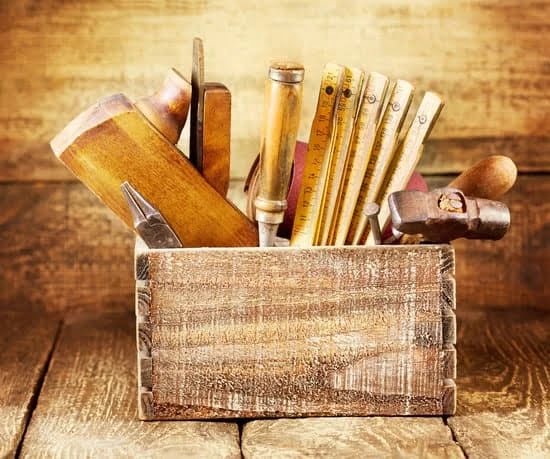Woodworking enthusiasts often come across the term “kerf” when working on various projects. But what is kerf in woodworking, and why is it important to understand this concept? In woodworking, the term “kerf” refers to the width of the cut made by a saw blade or other cutting tool. The size of the kerf can greatly impact the overall outcome of a woodworking project, making it crucial for woodworkers to have a good grasp of this concept.
Understanding the definition of kerf goes beyond simply knowing its width; it also involves knowing how different factors can affect it. From the type of saw used to create the cut to various techniques for controlling the kerf size, there are many aspects to consider when working with kerf in woodworking. By mastering these elements, woodworkers can ensure that their projects turn out as intended and avoid common mistakes that may arise from overlooking this important detail.
In this article, we will delve into the importance of kerf in woodworking projects, explore the different types of saws that can be used to create kerfs, discuss factors that can affect the width of a kerf, and provide insights into techniques for controlling kerf size. By learning more about this fundamental aspect of woodworking, both beginners and experienced craftsmen can enhance their skills and achieve better results in their creations.
Understanding the Definition of Kerf
In woodworking, the term “kerf” refers to the width of the material removed by a cutting tool, such as a saw blade, during the process of creating a groove or slit in a piece of wood. The kerf size is crucial in determining the accuracy and precision of cuts in woodworking projects. Understanding the definition of kerf is essential for woodworkers to achieve desired results and minimize wastage of materials.
What Is Kerf Width and How Is It Measured?
The width of the kerf is typically determined by the thickness of the cutting tool used in woodworking. For instance, a wider saw blade will create a thicker kerf compared to a finer blade. In woodworking terminology, kerf width is often expressed in terms of inches or millimeters. Measuring kerf accurately is important for ensuring that joints fit correctly and achieving clean, precise cuts in various woodworking applications.
Importance of Kerf Size in Woodworking
The size of the kerf plays a significant role in determining how snugly pieces fit together in carpentry projects such as joinery and furniture making. A precise kerf width ensures that components align properly when assembled, resulting in strong and durable structures. Moreover, understanding how to control and adjust kerf size can help woodworkers optimize material usage and minimize errors during cutting processes. By mastering the concept of kerf, craftsmen can enhance the quality and efficiency of their woodworking projects.
Importance of Kerf in Woodworking Projects
Kerf plays a crucial role in woodworking projects, influencing the overall outcome of the final product. Understanding the importance of kerf is essential for woodworkers to achieve precise cuts and accurate measurements in their projects. In woodworking, kerf refers to the width of material removed by a cutting tool, such as a saw blade. This factor directly affects the fit and finish of joints, the dimensions of pieces, and the overall aesthetics of the project.
One key aspect of the importance of kerf in woodworking projects is its impact on joinery. The width of the kerf can determine how tightly pieces fit together when assembled. A smaller kerf may result in a tighter joint, while a larger kerf may lead to gaps or loose connections. Woodworkers must consider this when choosing the appropriate saw blade for their project to ensure precise cuts that align perfectly during assembly.
Additionally, understanding kerf is crucial for achieving accurate measurements and dimensions in woodworking projects. By taking into account the width of the kerf when making cuts, woodworkers can adjust their measurements accordingly to compensate for material lost during cutting.
This precision is especially important when working on intricate or detailed projects where small discrepancies can have a significant impact on the final result. By mastering the concept of kerf in woodworking, artisans can elevate their craft and produce high-quality pieces with precision and accuracy.
Types of Saws Used to Create Kerf
In woodworking, the term “kerf” refers to the width of the cut made by a saw blade in a piece of wood. Understanding the concept of kerf is essential for achieving precise cuts and ensuring that woodworking projects turn out as intended. The size of the kerf can impact the fit, finish, and overall aesthetics of a final piece, making it an important consideration for woodworkers of all levels.
Types of Saws
There are several types of saws commonly used in woodworking to create kerf, each with its own unique characteristics and capabilities. One of the most common saws is the table saw, which uses a circular blade to make straight cuts in wood. Table saws are versatile tools that can be adjusted to control both the depth and width of the kerf, allowing for precise cuts in various materials.
Another popular choice for creating kerf is the band saw, which features a continuous looped blade that moves up and down in a vertical motion. Band saws are ideal for making curved or irregular cuts in wood due to their maneuverability and flexibility. They can also be used to create intricate designs or patterns by adjusting the blade tension and speed.
Lastly, hand saws are traditional tools that offer a level of control and precision not always achievable with power tools. While hand saws may require more physical effort and skill to use effectively, they can produce clean and accurate kerfs in wood when handled with care. Whether using a table saw, band saw, or hand saw, selecting the right tool for the job is crucial in determining the quality and outcome of your woodworking project.
Blade Selection
When choosing a saw to create kerf in woodworking projects, it’s essential to consider not only the type of saw but also the type and quality of the blade being used. Different blades have varying numbers of teeth per inch (TPI), tooth configurations (e.g. rip-cut or cross-cut), and materials (e.g.
carbide-tipped or high-speed steel), all of which can affect the width and quality of the kerf produced. Selecting the appropriate blade for your specific cutting needs will help achieve clean cuts with minimal tear-out or uneven edges.
Factors Affecting Kerf Width
In woodworking, understanding what is kerf is crucial for achieving precise and accurate cuts in your projects. Kerf refers to the width of the material that is removed by a saw blade when cutting through wood. It is essential to consider the kerf width when planning and executing woodworking projects to ensure proper fit and finish.
There are several factors that can affect the width of the kerf in woodworking. Some of these factors include:
- Type and sharpness of the saw blade being used
- Thickness and hardness of the wood being cut
- Feed rate or speed at which you are moving the saw through the material
- Angle at which the saw blade is cutting into the wood
These factors all play a role in determining the final size of the kerf in your woodworking projects. By understanding how each factor can impact the width of the kerf, you can make adjustments as needed to achieve your desired results.
When working on woodworking projects, it is important to pay close attention to the kerf width as it can greatly impact the overall outcome of your work. By mastering techniques for controlling kerf size and understanding the various factors affecting kerf width, you can enhance your woodworking skills and create high-quality pieces with precision and accuracy.
Techniques for Controlling Kerf Size
In woodworking, the term “kerf” refers to the width of the material that is removed by a cutting tool, such as a saw blade. Controlling the size of the kerf is crucial in ensuring accurate and precise cuts in woodworking projects. By understanding how to control kerf size, woodworkers can achieve better results and minimize errors in their work.
Here are some techniques for controlling kerf size in woodworking projects:
1. Blade Selection: Choosing the right saw blade with the appropriate number of teeth and tooth configuration can help control kerf size. A blade with more teeth will generally result in a narrower kerf, while a blade with fewer teeth will create a wider kerf. Additionally, selecting a blade with sharp teeth will produce cleaner cuts and reduce tear-out along the wood grain.
2. Adjusting Cutting Speed: Controlling the speed at which you feed the material into the saw can also impact kerf size. Slower feeding speeds may result in a wider kerf, while faster feeding speeds can lead to a narrower kerf. Experimenting with different cutting speeds on scrap pieces of wood can help determine the optimal speed for achieving the desired kerf width.
3. Proper Maintenance: Keeping your saw blades sharp and properly maintained is essential for controlling kerf size. Dull blades can tear through wood fibers instead of cleanly cutting them, resulting in a wider kerf. Regularly sharpening or replacing blades as needed will help maintain precision and accuracy in your cuts.
By applying these techniques and paying attention to factors that influence kerf width, woodworkers can effectively control the size of the cut made by their saw blades. Mastering this aspect of woodworking will lead to cleaner cuts, tighter joinery, and overall better quality in woodworking projects.
Common Mistakes to Avoid When Dealing With Kerf
When working on woodworking projects, understanding and properly managing kerf is crucial to achieving the desired results. One common mistake that many beginners make when dealing with kerf is ignoring the importance of blade selection.
The type of saw blade used can significantly impact the width of the kerf and ultimately affect the fit of joints in your project. It is essential to choose a saw blade that is appropriate for the material you are working with and that will create a clean and precise cut.
Another mistake to avoid when dealing with kerf is neglecting the issue of blade dullness. A dull blade can create a wider kerf than necessary, leading to gaps in joints and imprecise cuts.
Regularly sharpening or replacing your saw blades will help maintain the correct kerf width and ensure clean cuts in your woodworking projects. Additionally, using inadequate cutting speeds or feeds can result in tear-out or chipping along the edges of your workpiece, affecting the overall quality of your project.
Furthermore, overlooking the need for proper technique when creating kerfs can also lead to mistakes in woodworking projects. Incorrect positioning or angling of the saw blade, uneven pressure during cutting, or improper material support can all contribute to variations in kerf width and compromise the final outcome of your project. Taking the time to learn and practice correct cutting techniques will help you avoid these common pitfalls and achieve precise and professional results in your woodworking endeavors.
| Common Mistake | Impact |
|---|---|
| Ignoring blade selection | Can lead to ill-fitting joints |
| Neglecting blade dullness | Results in wider kerfs and imprecise cuts |
| Improper cutting techniques | Contribute to variations in kerf width |
Applications of Kerf in Woodworking Projects
Kerf in woodworking plays a vital role in various applications within woodworking projects. One of the primary uses of kerf is to create precise cuts in wood, allowing for accuracy and intricacy in design. By understanding the concept of kerf and its implications, woodworkers can achieve desired outcomes in their creations.
When using techniques such as sawing or carving, the kerf width directly impacts the fit and finish of joinery pieces. A wider kerf may result in loose joints, while a narrower one could lead to binding or cracking. Additionally, the depth of a kerf cut can influence the strength and durability of the final product. Therefore, knowing how to manipulate kerf dimensions is essential for achieving structural integrity in woodworking projects.
Moreover, kerf has applications beyond just cutting wood. In intricate marquetry or inlay work, understanding how kerfs interact with different materials is crucial for achieving seamless integration of pieces. By considering not only the width but also the angle at which kerfs are made, woodworkers can elevate their craftsmanship and create stunning visual effects in their projects.
| Importance of Kerf | Applications |
|---|---|
| Allows for precise cuts | In joinery pieces |
| Influences fit and finish | In marquetry or inlay work |
Conclusion
In conclusion, understanding what kerf is in woodworking is crucial for achieving precision and accuracy in your projects. Kerf refers to the width of the material that is removed by a saw blade, and it plays a significant role in the overall result of woodworking projects. By controlling the kerf size, woodworkers can achieve tight-fitting joints, smooth cuts, and consistent dimensions.
The importance of kerf in woodworking cannot be emphasized enough, as it directly influences the fit and finish of your final piece. The type of saw used to create the kerf, along with various factors such as blade thickness and material type, can all affect the width of the kerf. By mastering techniques for controlling kerf size and avoiding common mistakes, woodworkers can enhance the quality of their projects.
Ultimately, knowing how to manage kerf effectively can make a substantial difference in the outcome of woodworking projects. Whether you are working on intricate joinery or simple cuts, being mindful of what kerf is in woodworking and how it impacts your work will lead to more professional results. By recognizing the significance of kerf and implementing best practices for managing it, woodworkers can elevate their craftsmanship and create stunning pieces that showcase their skill and attention to detail.
Frequently Asked Questions
What Is the Purpose of a KERF?
The purpose of a KERF, also known as a saw kerf, is to create space for the blade of a cutting tool, usually a saw. It is the width of material removed during the cutting process.
What Is a KERF Cut in Woodworking?
In woodworking, a KERF cut refers to the width of material that is removed by a saw blade when making a cut in wood. This term is commonly used to describe how much material is being removed.
What Is an Example of a KERF?
An example of a KERF can be seen when using a table saw to make straight cuts in wood. As the blade cuts through the wood, it removes a small amount of material on each side of the cut, resulting in the overall width of the cut being slightly wider than the blade itself.

Hi everyone! I’m a woodworker and blogger, and this is my woodworking blog. In my blog, I share tips and tricks for woodworkers of all skill levels, as well as project ideas that you can try yourself.



